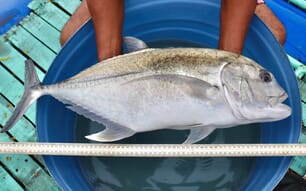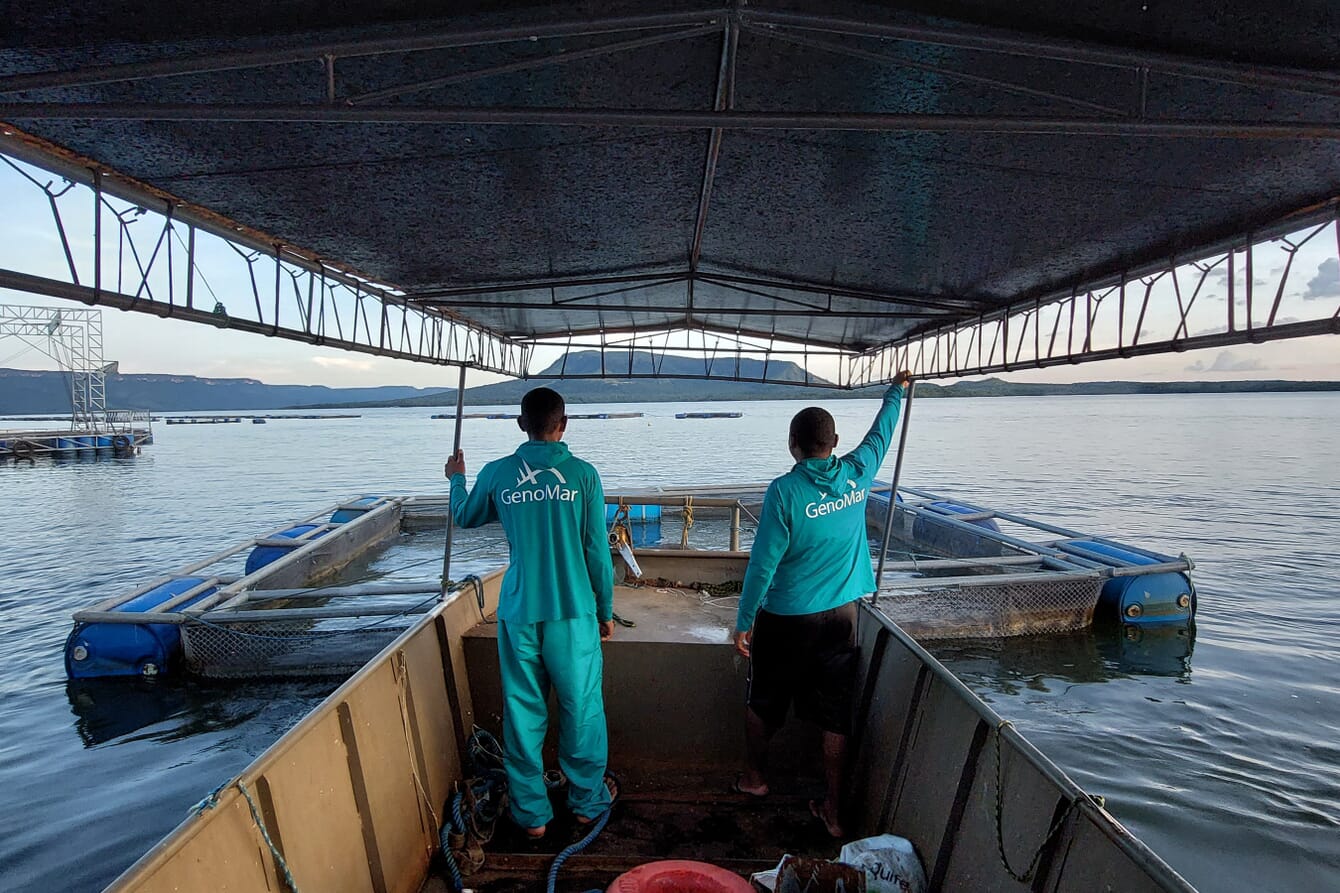
© GenoMar
GenoMar's premium genetic tilapia line - GenoMar 1000 - and a market leading local strain were compared in both pond and cage production systems under commercial conditions in Brazil, during a recent study. The results showed that GenoMar 1000 is superior for growth, survival, and uniformity, growing approximately 30 percent faster than the local strain during the test. With economic analysis suggesting a 31-36 percent annual increase in profits, the results demonstrate GenoMar 1000’s potential to enhance productivity, profitability, and sustainability in the Brazilian tilapia industry.
Nile tilapia (Oreochromis niloticus) is one of the most important farmed fish species in the world, and Brazil is one of the leading producers of tilapia globally. In recent years, the Brazilian tilapia industry has experienced a significant increase in production volumes, with annual production surpassing 579,000 tonnes in 2023.
As Brazil continues to develop its tilapia production capabilities whilst maintaining high-quality standards, the country is well-positioned to further increase its share in the global tilapia export market. Despite having vast potential, the comparatively young Brazilian tilapia farming industry continues to encounter significant challenges, with one major hurdle being the limited availability of highly productive and efficient genetic strains. Available local strains of tilapia typically exhibit lower productivity compared to strains that have undergone selective breeding for better growth, survival, and uniformity.
GenoMar Genetics is a leading producer of genetically improved tilapia fingerlings and juveniles under the brands GenoMar and Aquabel. Following 33 generations of selective breeding using state-of-the-art technologies, the GenoMar tilapia strain has been globally recognised for its superior growth, survival, uniformity, fillet yield and carcass quality. Widely regarded as one of the most sought-after tilapia strains in production, the GenoMar strain contributes significantly to enhancing productivity and profitability in the global tilapia industry. Now, GenoMar 1000 - the premium genetic line of the GenoMar strain - previously unavailable in Brazil, has been accessible to farmers since early 2024.
In this article, we have summarised the results of the three major key performance indicators (growth, survival, and uniformity) of GenoMar 1000 compared to a market leading strain of Nile tilapia under commercial pond and cage farming systems in Brazil.
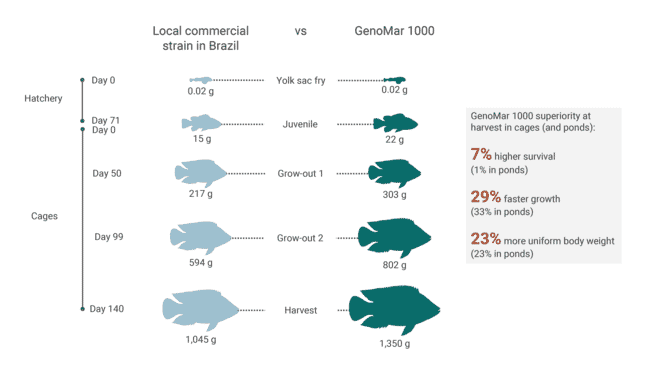
Growth development, final survival and uniformity of GenoMar 1000 compared to a local commercial strain in Brazil. The weights presented are an average of two cages with a 50/50 mix of the two strains (common garden design) © GenoMar
Growth
We have summarised the growth performances in the trial using three different measurement units:
- Body weight at harvest
- Average daily gain
- Time to reach 1kg
1. Body weight at harvest
The fish were harvested 140 days after stocking in both ponds and cages, with GenoMar 1000 outperforming the local strain in terms of growth in both ponds and cages under commercial rearing conditions (Figure 1). In ponds, GenoMar 1000 grew 33 percent faster than the local strain (1,196 g compared to 902 g). In cages, GenoMar 1000 grew 29 percent faster than the local strain (1,350 g compared to 1,046 g).

Growth curves for GenoMar 1000 and the local commercial strain across pond and cage production systems. The x-axis represents the days of culture (DOC), indicating the number of days after stocking in the production systems for common grow-out. © GenoMar
2. Average daily gain
The mean average daily gain (ADG) post stocking was higher for GenoMar 1000 compared to the local strain in both ponds and cage production systems (Figure 2). Grown in ponds, GenoMar 1000 grew at a mean daily rate of 8.37 grams, whilst the local strain of tilapia gained an average of 6.35 grams per day during the 140 day grow-out period. When reared in cages, ADG increased slightly for both strains, with GenoMar 1000 growing at an average of 9.49 grams per day, and the local strain gaining 7.37 grams per day, on average.
Simplified, this means that, compared with the local tilapia strain, GenoMar 1000 grew approximately 33 percent faster when reared in ponds, and 29 percent faster when cage reared.

Comparative analysis of average daily gain (ADG) at various body weights for GenoMar 1000 and the local commercial strain in different pond and cage production systems in Brazil © GenoMar
3. Time to reach 1 kg
GenoMar 1000 reached 1 kg faster than the local strain of tilapia in both pond and cage production systems. GenoMar 1000 reached 1 kg an average of 31.5 and 21.5 days faster than the local strain of tilapia in ponds and cages respectively (Figure 3).
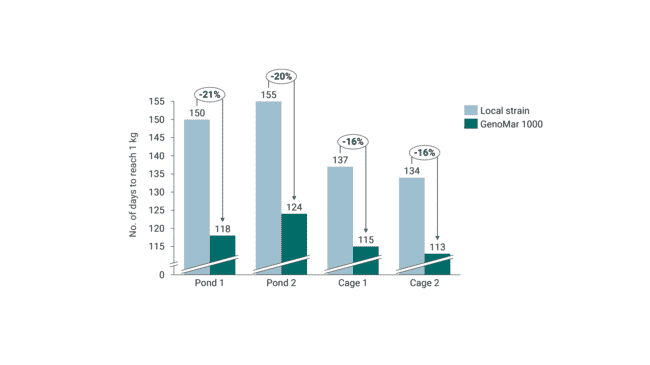
Comparative analysis of number of days to reach 1 kg for GenoMar 1000 and the local commercial strain of tilapia in different ponds and cage production systems. Number of days is calculated from the day of stocking in the production system for common grow-out © GenoMar
These findings, from three different growth metrics, demonstrate the significant growth advantages offered by GenoMar 1000, highlighting its potential for enhancing tilapia farming productivity and sustainability.
Survival
In addition to growth rate, another key performance indicator for tilapia producers is survival rate, which holds paramount importance for both tilapia hatcheries and grow-out farmers. Thus, we have compared the survival rate of GenoMar 1000 and the local strain for two different time intervals.
Survival in hatchery stage (up to 10 g)
Higher survival rates allow hatcheries to produce more tilapia fry and fingerlings without increasing their consumption of resources. GenoMar 1000 tilapia were found to have significantly higher survival in the hatchery stage: both from 0.016 g to 1 g (sex reversal stage) and from 1 g to 10 g (pre-grow-out stage).
During the sex reversal stage, hatchery survival rates for GenoMar 1000 fish and the local tilapia strain were 56 percent and 36 percent, respectively. For the pre-grow-out stage, survival rates increased for both strains, with GenoMar 1000 tilapia surviving at a rate of 87 percent, compared to 78 percent for the local strain. Overall, the total hatchery survival rate for GenoMar 1000 fish was 72 percent higher than that for the local strain of fish.
Grow-out stage
The fish in the experiment were not vaccinated so that the effect of their genetics on their survival could be observed. Thus, the difference in survival between the two strains is likely due to their different adaptations and abilities to tolerate diseases and general stress during grow-out.
GenoMar 1000 tilapia survived better in cages (p<0.001), while there was no significant difference in survival between the two strains in ponds (Figure 4). This is likely because the ponds were located in a biosecure facility with low disease pressure, whilst the cages were placed in the Lake Palmas, an open environment with less biosecurity.
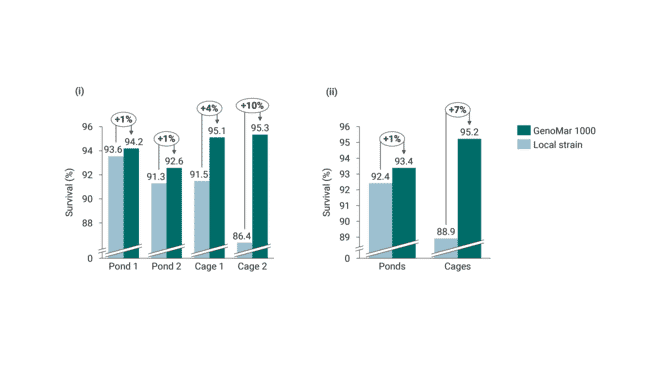
Survival during grow-out for GenoMar 1000 and the local commercial strain in pond and cage production systems (left), and the mean of pond and cage production systems (right) © GenoMar
Streptococcus agalactiae, a common fish pathogen, was detected at the cage site during the experiment, but no treatment was applied. The higher survival of GenoMar 1000 at this site suggests improved resistance to Streptococcosis infection due to specific selection for this trait in every generation since 2016.
Despite being selected in an Asian environment; the trial demonstrates no negative effect on the adaptability and survivability of GenoMar 1000 in Brazilian conditions. On the contrary, the survival of GenoMar 1000 in the cage environment was significantly better.
Cage environments typically carry higher pathogenic pressure and stress levels. GenoMar 1000 has been bred to be more resistant to various economically important pathogens and production environments for a longer period.
Total survival from yolk sac fry to harvest size
Out of ten yolk sac fry from GenoMar 1000, six survived until 1 g (survival rate = 56 percent), compared to four from the local strain (survival rate = 36 percent). The number of fish is rounded to the nearest whole number.
From these survived fingerlings, five from GenoMar 1000 survived the pre-grow-out stage and became juveniles (total survival rate = 48 percent), whilst three from the local commercial strain survived (total survival rate = 28 percent).
Extending this comparison to the grow-out in cages, all five juveniles from GenoMar 1000 survived until harvest (survival rate = 95.2 percent), compared to only two from the local strain (survival rate = 88.9 percent). Further hazard analysis showed that the risk of death during the grow-out stage is significantly decreased by 49 percent in GenoMar 1000, compared to the local strain of tilapia.
To summarise the entire experimental period: Out of ten yolk sac fry from GenoMar 1000, five survived until harvest, compared to two from the local strain (Figure 5). These figures highlight GenoMar’s commitment to advancing disease resistance and increasing tilapia survival via genetics. These findings validate the efficacy of our innovations in the tilapia breeding programme and demonstrate the potential for sustainable fish farming practices using GenoMar 1000 fingerlings.
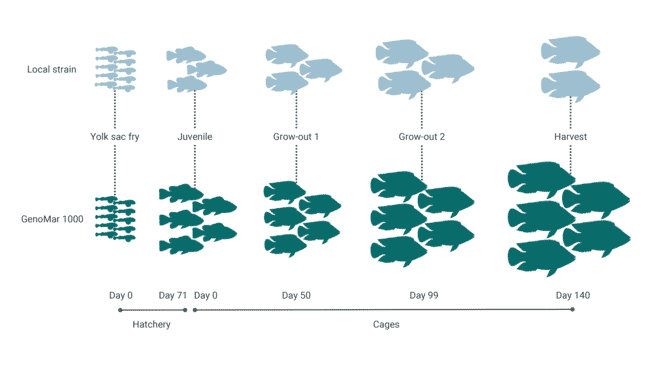
Out of ten yolk sac fry of GenoMar 1000, five survived until harvest, compared to two of the local commercial strain © GenoMar
Uniformity
Uniformity was measured by calculating the coefficient of variation (CV) of body weight at harvest (BWH). A higher CV means lower uniformity. GenoMar 1000 was found to be more uniform than the local strain of tilapia in both cages and ponds, exhibiting, 23 percent more uniformity than the local strain of tilapia on average (p<0.001).
Figure 6 describes the size variance of simulated populations of Genomar 1000 tilapia and the local strain for their respective CV values, the target weight being 1 kg. A significantly higher proportion of the GenoMar 1000 fish reached the desired harvest weight in both ponds and cage production systems, underscoring its suitability as genetic material for large-scale grow-out operations.
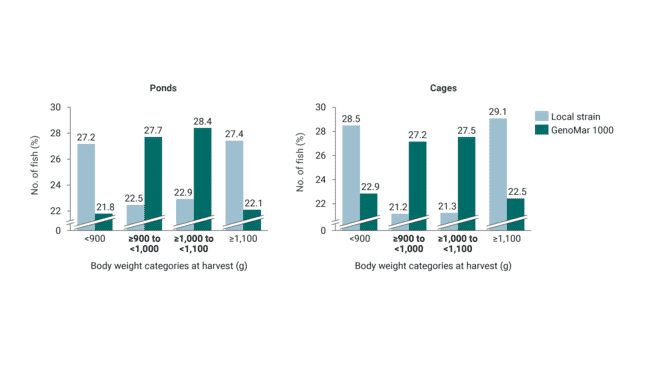
Simulation of a population of 20,000 from each of GenoMar 1000 and the local commercial strain of tilapia to show the size distribution of the fish populations when the targeted average harvest body weight was 1 kg © GenoMar
Performance and yield of juveniles
In the preceding sections, we evaluated the growth and survival of the two strains independently. However, to comprehensively assess the effectiveness of stocked juveniles in terms of both growth and biomass conversion into harvestable fish - a vital consideration for farm profitability - we required an index comprising both these traits. In the following sections we have summarised the performance and yield of juveniles using two different metrics:
- Performance (g/fish/day)
Performance is calculated as:

This metric essentially calculates the average biomass production (in g) of each stocked juvenile (corrected to the initial stocking weight of the juvenile) per day in the production system.
In the cage production system, the GenoMar 1000 juveniles exhibited an average performance 38 percent higher than the juveniles of the local strain (Figure 7). Each stocked juvenile of the local commercial strain yielded on an average 6.5 g of harvestable biomass per day. Each stocked GenoMar 1000 juvenile surpassed this, producing approximately 2.5 g more, amounting to 9 g of harvested biomass per day.
Similarly, in the pond production system the GenoMar 1000 juveniles showed an average performance that was 33 percent higher than the juveniles of the local strain (Figure 7). Each stocked juvenile of the local strain on average yielded 5.9 g of harvestable biomass per day, whilst the GenoMar 1000 juveniles produced 7.8 g of harvestable biomass per day.
2. Yield (kg harvested/unit of production area)
The yield is calculated as:

This metric essentially calculates the average biomass production (in kg) per unit area (m2 of the surface area of the pond or m3 of the cages in one harvest). The difference in the values for the yield between GenoMar 1000 and the local strain of tilapia is similar to that for the performance (Figure 7). In the pond-based production system, the local commercial strain yielded 1 kg/m2 whilst GenoMar 1000 yielded an additional 0.4 kg for the same unit area. Similarly, in the cage production system the local strain yielded 25.6 kg/m3, whilst the GenoMar 1000 yield exceeded this, yielding 35.4 kg/m3.
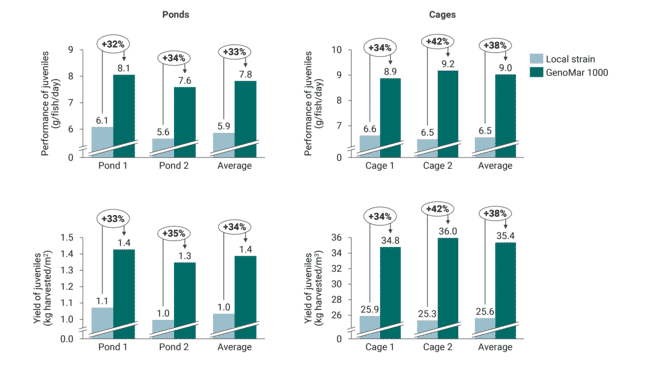
Comparison of performance of juveniles (g per fish per day) and yield of juveniles (kg harvested per unit area) in the pond and cage production systems. A higher value for performance and yield indicates better growth, survival, and productivity of the juveniles in the production system © GenoMar
Economic analysis
Choosing the right genetics is a strategic decision that significantly influences the long-term success of a tilapia production venture. For this, an economic analysis is imperative, providing insights into the monetary benefits for farmers and aiding them in making informed decisions.
Based on the outcomes of this trial, we conducted an economic analysis for both cage and pond production systems, focusing on harvesting tilapia at 1 kg. Both scenarios simulated a stocking of 200,000 tilapia.
Due to the fact that the ponds and cages were shared by fish of both strains, the feed conversion could not be directly measured and compared. Consequently, we used the same feed conversion ratios (FCRs) for both strains within each production system. However, in practice, we have observed that superior growth and increased survival typically correlate with enhanced feed efficiency, ultimately increasing profit margins.
Considering a higher investment in genetically improved fingerlings from GenoMar 1000, a fish farm stocking 200,000 fish in a cage can potentially achieve an annual increase in harvest of 128,895 kg and a profitability increase of R$ 360,834 (equivalent to US $72,167), representing a 36 percent increase in profits. Similarly, in the pond production system, the potential increase in harvest is 122,625 kg, with a profitability increase of R$ 312,664 (equivalent to US $62,533), reflecting a 31 percent increase in profits.
Methodology
Experimental population formation
To establish the experimental populations, broodstocks from GenoMar 1000 and the local strain were reproduced within the same facility in Tocantins. This approach aimed to synchronise spawning and minimise environmental variations.
The experimental populations were created using a batch of eggs collected within the same week to ensure similar developmental stages, thus reducing the hatching interval of the larvae to a maximum of five days, mirroring commercial practices (Figure 8).
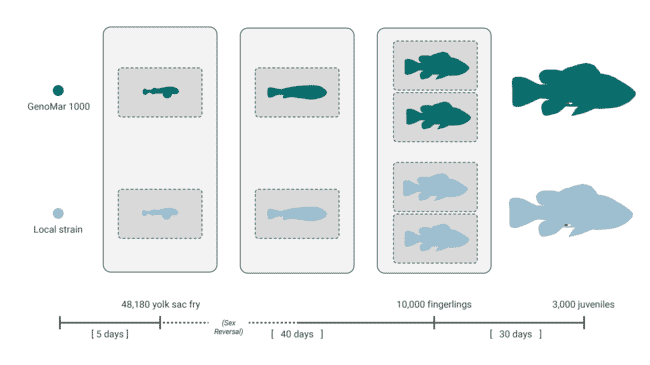
Experimental design from hatching till individual tagging (pre-grow-out) before stocking for grow-out in ponds and cages © GenoMar
At one day post-hatching, 48,180 yolk sac fry from each strain were stocked in two separate hapas within the same pond, receiving identical treatment. This nursery stage lasted 40 days, with sexual reversal during the first 21 days. Subsequently, in the pre-growth stage, 10,000 fingerlings of each strain were randomly collected and stocked in four hapas, two for each strain (with two additional hapas for backup), within the same pond to minimise environmental effects.
Over the next 30 days, these fish were raised under identical water quality conditions and received the same feeding programme until they reached tagging size. Subsequently, 3,000 juveniles from each strain were randomly collected from all hapas, tagged, and transferred to the grow-out stage for a common garden experiment.

© GenoMar
Common garden experimental design
Following individual tagging, an equal number of fish from GenoMar 1000 and the local strain of tilapia (selected randomly) were stocked together in two different ponds and two different cages for a blind grow-out. This design ensures that the two groups of fish were reared under the same environmental conditions in each pond and cage (Figure 9).
The 32 m3 cages were stocked to a density of 55 juveniles per m3, with an expected harvest of 70 kg/m3. Comparatively, the 500 m2 ponds were stocked to a density of 2.48 juveniles per m2, with an expected harvest of 3 kg/m2.
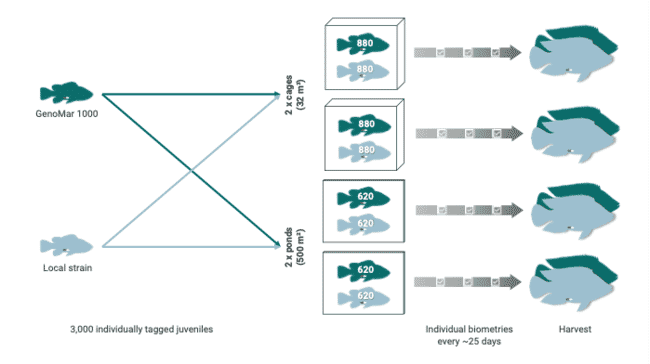
Experimental design of the individually tagged fish for blinded common garden grow-out in cages and ponds © GenoMar
The cages were positioned in Lake Palmas, where commercial tilapia farming is already in operation. The ponds were located within GenoMar’s Tocantins facilities. Activities at both locations were synchronised, and a strict feeding programme was followed to simulate commercial production conditions. The grow-out phase was closely monitored until harvest, with individual biometry measurements taken approximately every 25 days.

The grow-out phase of the trial was conducted in ponds at Serra da Tilapia, Monte do Carmo in Tocantins, Brazil (left) and in cages at Lago de Palmas, Lajeado in Tocantins, Brazil (right). © GenoMar
Feeding programme
A commercial feeding programme was followed during the trial. For the initial six weeks post-hatching, the tilapia was provided with commercial feed comprising 45 percent protein, followed by a switch to a feed containing 36 percent protein from week seven to nine. As the tilapia continued to grow, this diet was further adjusted to one containing 32 percent protein, starting from week ten.
Feed conversion ratio
Due to the nature of the trial, it was not possible to differentiate the FCR for GenoMar 1000 and the local strain of tilapia separately. Therefore, the FCR for the combined group is presented in Figure 10 to demonstrate that the FCR rate in the trial was within normal parameters.
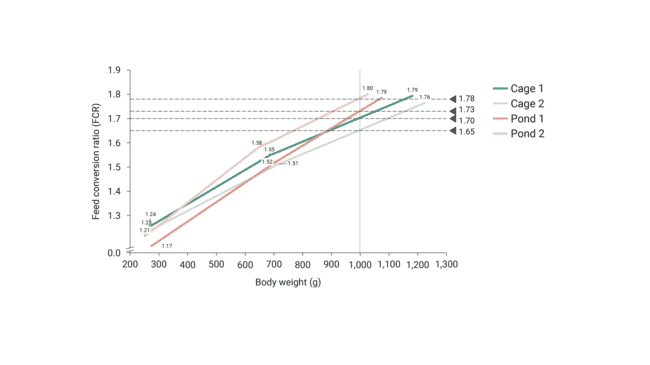
Combined feed conversion ratio (FCR) of the production systems at different average body weight of the fish in each cage and pond. The values listed on the right-hand side with inverted triangles represent the predicted FCR when the fish are around 1 kg in each production environment © GenoMar
Temperature and dissolved oxygen
During the common garden grow-out the temperature and dissolved oxygen levels in all cages and ponds were monitored and recorded throughout the experiment and are presented in Figure 11.
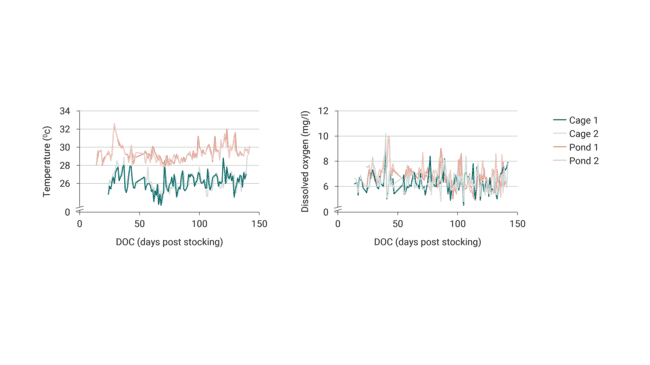
The temperature and dissolved oxygen in different ponds and cages during the grow-out period of the experiment © GenoMar
Implications for Brazilian tilapia farmers
A switch to GenoMar 1000 tilapia can be a very beneficial decision for Brazilian tilapia farmers, impacting productivity, profitability, sustainability, and animal welfare:
- GenoMar 1000 grow approximately 30 percent faster and have a higher survival rate and uniformity compared to a local commercial strain, leading to a potential annual increased profitability of approximately 31-36 percent
- Faster growth and increased survivability lead to better productivity, significantly reducing the cost of production and environmental risk
- Higher survival rates reflect improved health and animal welfare
How does GenoMar 1000 achieve such improved production performance? The answer lies in selective breeding and the use of advanced scientific technology. GenoMar 1000 was developed over many generations by carefully selecting fish with the best growth, survival, and fillet yield traits, resulting in a product that is genetically predisposed to grow quickly and efficiently.
Availability of GenoMar 1000 fingerlings to Brazilian tilapia farmers
First sales of such high performing premium GenoMar 1000 fingerlings were made to a selected group of key customers and large tilapia producers of Brazil in early 2024. They are now available to all Brazilian tilapia farmers.



